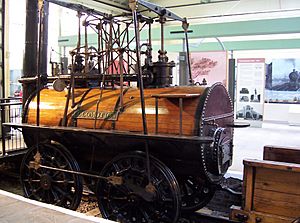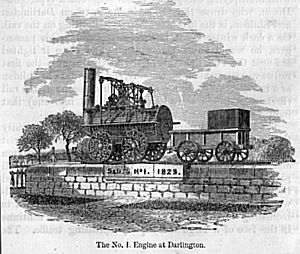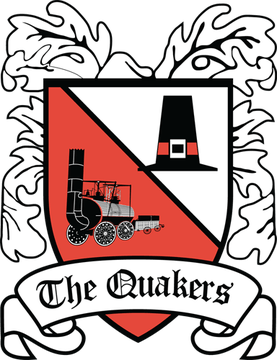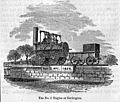Locomotion No. 1 facts for kids
Quick facts for kids Locomotion No. 1 |
|
 |
|
| Locomotion at Darlington Railway Centre and Museum | |
| Power type | Steam |
|---|---|
| Builder | Robert Stephenson and Company |
| Build date | 1825 |
| Configuration | 0-4-0 |
| Driver diameter | 48 in (1.219 m) |
| Locomotive weight | 6.5 long tons (7.3 short tons; 6.6 t) |
| Fuel type | Coke |
| Fuel capacity | 2,200 lb or 1,000 kg or 1.00 t |
| Water capacity | 240 imp gal or 290 US gal or 1,100 L |
| Boiler pressure | 50 psi (0.34 MPa) |
| Heating surface: Total | 60 sq ft (5.57 m2) |
| Cylinders | 2 |
| Cylinder size | 9 in × 24 in (229 mm × 610 mm) |
| Tractive effort | 1,900 lbf (8.5 kN) |
| First run | 27 September 1825 |
| Retired | 1857 |
| Disposition | static display at the NRM Locomtion Museum, Shildon |
Locomotion No. 1 (first called Active) is a very old steam locomotive. It was built in 1825 by famous railway engineers George and Robert Stephenson. They built it at their company, Robert Stephenson and Company. This locomotive made history by pulling the first train with passengers on a public railway. This railway was called the Stockton and Darlington Railway (S&DR).
The Stockton and Darlington Railway Company ordered Locomotion No. 1 in 1824. Its design used ideas from George Stephenson's earlier locomotives. It was likely the first locomotive to use coupling rods. These rods linked the driving wheels together. This helped stop the wheels from slipping on the rails. However, its boiler, called a centre-flue boiler, was not very good. It did not heat water as well as later boilers.
In September 1825, Locomotion No. 1 pulled the first train on the Stockton and Darlington Railway. This was the first time a locomotive ran on a public railway. On July 1, 1828, the locomotive was badly damaged. Its boiler exploded at Aycliffe Lane station. Sadly, its driver, John Cree, died. The locomotive was rebuilt. But new designs came out quickly, making Locomotion No. 1 old-fashioned within ten years. It was used on the railway until 1841. After that, it was changed into a stationary engine. In 1857, because it was so important to history, Locomotion No. 1 was saved and put on display. Today, it is at the NRM Locomotion museum. A working copy of Locomotion was also built. It is now at NRM Shildon until 2024. Then it will return to Darlington for a special celebration.
Contents
History of a Famous Engine
How Locomotion Began
On June 23, 1823, a company called Robert Stephenson and Company started. It was founded by George Stephenson, his son Robert, and two businessmen. A few months later, in November, the Stockton & Darlington Railway Company placed a big order. They wanted four stationary engines.
Then, on September 16, 1824, the S&DR ordered two steam locomotives. Each cost £550. This order was very important for history. The first of these locomotives was named Active. It was later called Locomotion No. 1. It became the first steam locomotive to pull a passenger train on a public railway.
Designing the Locomotion
The design of Locomotion used and improved on George Stephenson's earlier locomotives. The locomotive weighed about 6.6 tonnes. Many parts, like the boiler, cylinders, and wheels, were made of cast iron. The frame was made of wood. It had four driving wheels, each about 4 feet (1.2 m) wide.
Locomotion No. 1 used high-pressure steam. This steam was made in a special boiler. It powered two vertical cylinders, each 9 inches (230 mm) wide. These cylinders were partly inside the boiler. The boiler had a blastpipe in the chimney. This single boiler design did not heat water as well as newer boilers. Locomotion No. 1 could go about 15 mph (24 km/h). Power was sent from the cylinders through coupling rods. These rods connected the driving wheels. This was a new idea that helped stop the wheels from slipping.
Some experts say that Locomotion No. 1 is most famous for pulling the first passenger train. Its design was important, but its role in history was even bigger.
How Locomotion Operated
In September 1825, the finished Locomotion No.1 was moved by road. It went from Newcastle to Darlington. On September 26, the day before the railway opened, it had a test run. It went between Shildon and Darlington. Some railway directors rode in the first passenger coach, called ‘’Experiment’’. The driver was James Stephenson, George Stephenson's older brother. He sat on a small platform next to the boiler. The fireman, William Gowling, stood on a footplate.
On September 27, 1825, Locomotion No.1 pulled the first train on the Stockton and Darlington Railway. George Stephenson himself was the driver. The train had Locomotion No.1, eleven wagons of coal, the coach ‘’Experiment’’, and 20 more wagons. These wagons carried passengers, guests, and workers. About 300 tickets were sold, but many more people were on board. The train weighed about 80 tonnes and was about 400 feet (120 m) long. It reached a top speed of 12 miles per hour (19 km/h)). The first 8.7 miles (14.0 km) of the trip took two hours. It was slowed by a derailed wagon and a problem with its pump. This meant it only went about 8 miles per hour (13 km/h) on average.
Locomotion No. 1 pulled trains on the S&DR for three years. On July 1, 1828, it was badly damaged. Its boiler exploded while the train was stopped at Aycliffe Lane station. Sadly, the driver, John Cree, died. Another worker was hurt. The boiler exploded because the driver had tied down a safety valve. This made the pressure inside the boiler too high.
Locomotion No. 1 was rebuilt and put back into service. It ran until 1850. On June 4, 1846, it pulled the first train on the Middlesbrough and Redcar Railway. This was a smaller railway connected to the S&DR.
After it stopped being used as a locomotive, Locomotion was bought by Joseph Pease and Partners. It was changed into a stationary pumping engine. It was used at their coal mines in South Durham until 1857.
Locomotion in Town Symbols
Locomotion No. 1 is a very important part of Darlington's history. It is shown on the town's official coat of arms. You can also see it on the badges of Darlington's football and rugby clubs.
Preserving a Piece of History
In 1856, Joseph Pease and his family paid £50 to save Locomotion No. 1. They saved it from being scrapped when its working life ended. It was one of the first locomotives ever saved for history.
On a warm Saturday, June 6, 1857, a special ceremony took place. Flags were flying outside the North Road station. A band played, and a procession arrived. They were there to lay the foundation for a stand. Locomotion No. 1 would be placed on this stand. Joseph Pease, a leader of the S&DR, laid the stone. Cannons were fired to celebrate. Many speeches were given.
People remembered George Stephenson and his son Robert. Henry Pease spoke from the newly laid stone. He was happy that their first locomotive, Locomotion No. 1, would be placed in a good spot. This would help future generations remember one of the greatest events in the world. The crowd cheered loudly.
Railway officials then went to the Sun Inn for a meal and more speeches. Later, they went to Henry Pease's home for tea and games.
Between 1857 and the 1880s, Locomotion was usually on display. It was at Alfred Kitching's workshop. It also traveled to many exhibitions. It was shown in Philadelphia in 1876, Paris in 1889, and Edinburgh in 1890. Locomotion No.1 was even steamed up again for special events. This included the Stockton and Darlington Railway's 50th birthday in 1875. But it always returned to Darlington.
From 1892 to 1975, Locomotion was on display. It was on a platform at Darlington's main station, Bank Top. It was next to another old locomotive called Derwent. In 1924, it was cleaned up to look its best. During World War II, it was moved to a safer place. This was because of the danger of bombing. In 1975, Darlington built its railway museum around Locomotion No. 1.
As railway ownership changed, Locomotion became part of the National Collection in 1968. This collection is now part of the Science Museum Group. The locomotive has stayed in Darlington since 1857. In recent years, it has been on display at the Head of Steam museum in Darlington. This museum is in the same building as Darlington's North Road station. Since 1975, the National Railway Museum (NRM) has loaned it to Head of Steam. The NRM wants to move it to its museum in Shildon in 2021. Darlington council does not want it to move. They say the locomotive has always been linked to Darlington. It is even on the town's coat of arms.
The original Locomotion is too old and fragile to run again. So, a working copy was built in 1975. This copy is usually at Beamish Museum. It was moved from Head of Steam Museum by NRM Shildon on March 7, 2021.
See also
 In Spanish: Locomotion No. 1 para niños
In Spanish: Locomotion No. 1 para niños
Images for kids






